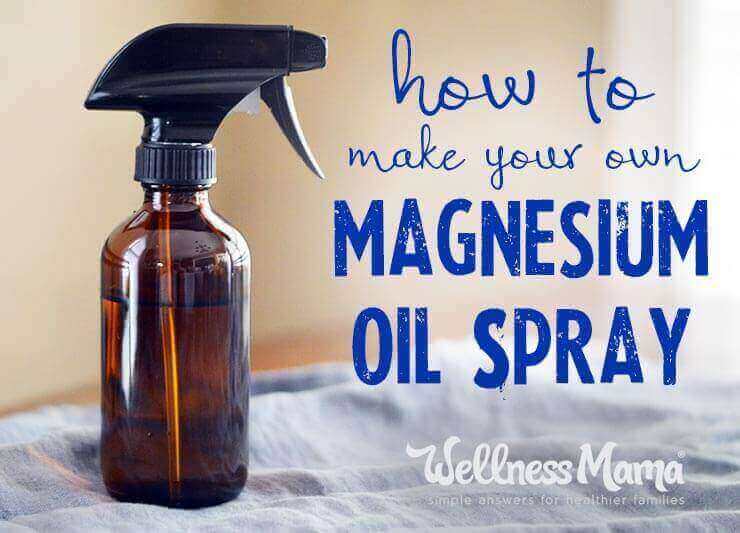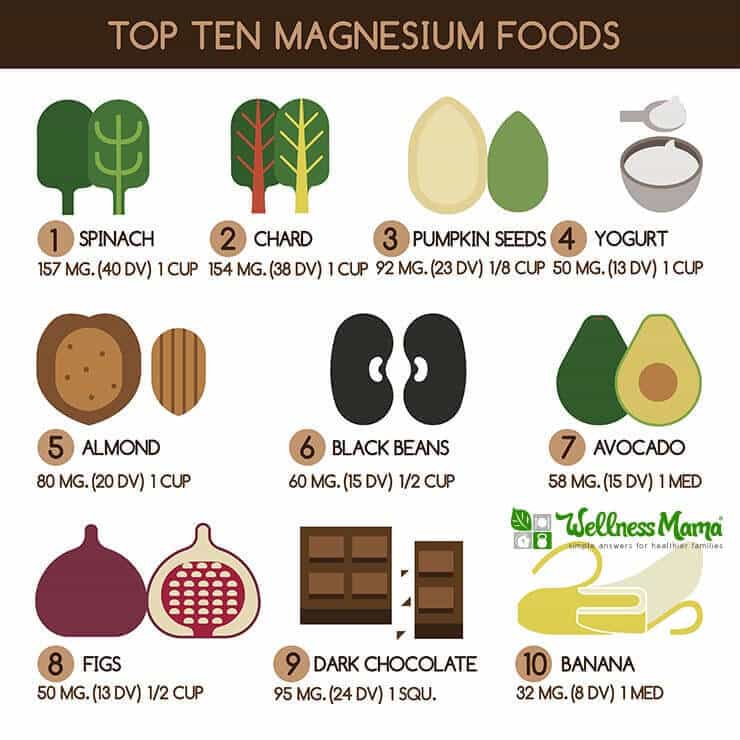

I’ve written before about how I use magnesium daily and why I feel it is such a vital part of overall wellness. Many people are deficient in this vital mineral that the body uses for hundreds of reactions. Every cell in the body needs magnesium in some way, and it is vital for bone, tooth, muscle, and joint health as well as for optimal sleep and stress reduction.
Why Magnesium Oil?
 Deficiency of magnesium is widespread because many of us have lifestyle factors that actively deplete magnesium such as lack of sleep, excess stress, or alcohol/caffeine/sugar consumption. On top of that, many natural sources of magnesium are becoming depleted (such as the soil due to over-farming and high pesticide use) and water filtration systems remove much of the naturally occurring magnesium in water.
Deficiency of magnesium is widespread because many of us have lifestyle factors that actively deplete magnesium such as lack of sleep, excess stress, or alcohol/caffeine/sugar consumption. On top of that, many natural sources of magnesium are becoming depleted (such as the soil due to over-farming and high pesticide use) and water filtration systems remove much of the naturally occurring magnesium in water.
The ocean is still a wonderful source of magnesium and trace minerals, but for those of us who don’t have daily access to a beach, transdermal magnesium oil can be the easiest and most effective way to increase magnesium levels.
I use magnesium daily in some form and use magnesium oil on my skin most often. There are some really high quality pre-made magnesium oils available now (this is my favorite) but it is also possible to make magnesium oil easily and inexpensively from magnesium chloride flakes. I’ve used one of these forms of magnesium oil for years and notice a definite difference when I forget to use it.
DIY Magnesium Oil Ingredients
- ½ cup Magnesium Chloride Flakes
- ½ cup distilled water
- A glass bowl or glass measuring cup
- A glass spray bottle (plastic will work too)
Magnesium Oil Instructions
- Boil the distilled water. It is important to use distilled to extend the shelf life of the mixture. Put the Magnesium Chloride
- Flakes in the glass bowl or measuring cup and the pour the boiling water over it.
- Stir well until completely dissolved. Let cool completely and store in the spray bottle. Can be stored at room temperature for at least six months. I keep in my bathroom to use daily.
How to Use Magnesium Oil
Spray on arms, legs, and stomach daily. I use 10-20 sprays per day. It will tingle on the skin the first few times it is used, and this is normal. It should fade after a few applications, but you can dilute with more water if it bothers you too much.
You can leave on the skin or wash off after 20-30 minutes. I usually apply after a shower and then use coconut oil or a lotion bar to moisturize about 5 minutes later.
Other Ways to Get Magnesium
Magnesium is found in some foods, though the amounts present in many foods are declining due to poor soil quality and over farming. Foods that contain magnesium include:

There are also magnesium supplements that can be taken internally, including drink mixes like Natural Calm (this one is my favorite) though many people have difficulty absorbing magnesium internally and find topic magnesium a more effective method.
FAQs About Magnesium Oil
This post has generated hundreds of comments and questions and I’ve tried to answer the most common ones here:
Why is this called an oil when there is no oil in it?
Good question. This is actually a highly saturated mineral solution of magnesium but when it goes on the skin it tends to feel somewhat like an oil and was named “Magnesium Oil” for this reason. Confusing? A little… but I didn’t come up with the name. Even commercial brands of magnesium oil (including my favorite) use that term.
What type of magnesium is best?
From the research I found, magnesium chloride seems to be the most absorbable and least irritating form that is readily available for purchase by the general public. Some brands (like this one) use magnesium chloride hexahydrate, which is really gentle on my skin and non-irritating, but not possible to make at home.
Would epsom salts work?
Yes, and check out the comments as several readers share experience with making an epsom salt based spray. The difference is that epsom salts are magnesium sulfate and can be more drying and not absorb as easily into skin. Personally, I find epsom salt based sprays too drying.
Will Natural Calm work for the magnesium?
Nope! It uses magnesium citrate, which is easier to absorb internally but really irritating to the skin. This would also leave a white film and make a big mess. I don’t recommend it.
Is it good to add calcium to the spray too?
I personally wouldn’t. In theory, you could and it would dissolve decently well, but it would leave a white film on skin and calcium is not as easily absorbed through skin. Also, it seems that many people get plenty of calcium and not enough magnesium, so this would potentially not be as beneficial.
Can this go in a plastic bottle?
In theory yes and it should work just fine. I prefer glass whenever possible, especially since glass bottles are readily available now. My personal favorites are these gorgeous cobalt blue bottles.
Can I use this on babies/kids/my pets?
Ask your pediatrician/vet to be sure before using any product on a child or pet. Personally, I use this spray on my children at night to help them sleep more soundly.
Can I use magnesium while pregnant/nursing?
Again, check with a doctor before using anything while pregnant nursing, but I have personally used it through several pregnancies with great results.
This is suppose to improve sleep- why does it seem to keep me up?
From all of the comments, there seems to be a small group of people who have an opposite reaction to magnesium. While it promotes restful sleep for many people, this small percentage seems to have trouble sleeping for a few hours after taking magnesium. My mom had this problem and found that she did best when she took or used magnesium spray around lunch time.
Why does this oil cause burning/tingling on some people?
One theory is that those who are deficient will have a tingling or burning reaction to magnesium oil. I did notice that it seemed to irritate me much more at first and that I soon adjusted and didn’t have a problem with this at all, but I don’t have any science to back up the deficiency theory. I also found that this particular magnesium oil didn’t tingle or burn at all.
What about adding essential oils to the mixture?
There are some risks associated with certain essential oils but some can also be very beneficial. Personally, I’d check with a qualified practitioner or aromatherapist before using any essential oil in this recipe.
Can this be used as deodorant?
Yep! I have a separate recipe for a spray deodorant that is basically this recipe anyway and this spray on its own works great for me now.
Have you tried magnesium to help reduce stress, improve sleep or for another reason? Ever tried to make your own? Share below!
Continue Reading...How To Make Your Own Magnesium Oil
from Blog – Wellness Mama® http://wellnessmama.com/5804/make-your-own-magnesium-oil/?utm_source=rss&utm_medium=rss&utm_campaign=make-your-own-magnesium-oil
via SEO Derby
No comments:
Post a Comment